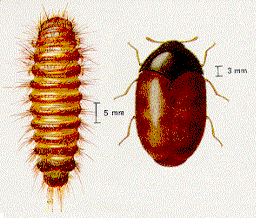The Warehouse Beetle: Identification and Prevention Methods
There are several species of beetles that will attack dried plant and animal materials in storage. Many stored product pests arrive on shipments and some can enter from outdoors. The warehouse beetle is one species that will come in with shipments and enter from the exterior environment. Because it has two potential pathways into a building, it is one of the most common stored product beetles to infest food facilities. It is named, warehouse beetle because it commonly infests warehouses and other areas where food is stored.
 Identification
Identification
The adults are about 1/8” in length and dark brown in color. They have 4 wavy light colored wavy bands on the wings. The larva, one of the immature stages, can reach ¼” in length and is tapered at each end of the body. They are dark brown in color with alternating cream-colored sections.
Damage caused by Warehouse Beetles
The warehouse beetle is one of the few stored product pests, which in addition to contaminating food, can be of medical importance. The larvae have numerous hairs on their body. One larva may have over 2,000 hairs. Some of these hairs will be spear or barbed shaped. If the larvae or its shed skins are ingested in the food it is infesting, they may cause intestinal distress.
In addition to their medical significance, the larvae are the stage responsible for damaging and contaminating food. It will infest a wide range of grain-based products like flour, candy, cereal and pasta. They will feed on animal proteins and may be associated with dry pet food and powdered milk or cheese-based products.
Preventing Warehouse Beetles from Invading your Business
-
Perform inspections on incoming shipments to look for warehouse beetles and other pests. Reject any infested shipments.
-
Practice first in, first out (FIFO) system of stock rotation. The longer a material remains in inventory, the more likely it is to be infested.
-
Keep doors closed when not in use and pest proof vents and other openings to exclude beetles.
-
Clean up food spills promptly, including underneath racking and gondolas.
-
Discard any infested product promptly and remove from the store.
-
Report any sightings to you pest management professional.
